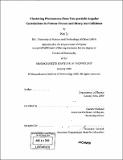| dc.contributor.advisor | Gunther Roland. | en_US |
| dc.contributor.author | Li, Wei, Ph. D. Massachusetts Institute of Technology | en_US |
| dc.contributor.other | Massachusetts Institute of Technology. Dept. of Physics. | en_US |
| dc.date.accessioned | 2010-03-25T15:14:45Z | |
| dc.date.available | 2010-03-25T15:14:45Z | |
| dc.date.copyright | 2009 | en_US |
| dc.date.issued | 2009 | en_US |
| dc.identifier.uri | http://hdl.handle.net/1721.1/53207 | |
| dc.description | Thesis (Ph. D.)--Massachusetts Institute of Technology, Dept. of Physics, 2009. | en_US |
| dc.description | Cataloged from PDF version of thesis. | en_US |
| dc.description | Includes bibliographical references (p. 167-178). | en_US |
| dc.description.abstract | Results on two-particle angular correlations in proton-proton (/-s = 200 and 410 GeV) ,Cu+Cu and Au+Au collisions (js = 200 GeV) are presented over a broad range of pseudorapidity ([eta]) and azimuthal angle ([phi]). The PHOBOS experiment at the Relativistic Heavy Ion Collider (RHIC) has a uniquely large coverage for inclusive charged particles, giving the opportunity to explore the correlations at both short- and long-range scales. In proton-proton collisions, a complex two-dimensional correlation structure in [delta eta] and [delta phi] emerges, which is interpreted in the context of an independent cluster model. The effective cluster size and its decay width are extracted from the two-particle pseudorapidity correlation function at various collision energies and multiplicities. Similar cluster like short-range structure is also observed in Cu+Cu and Au+Au col-lisions. The effective cluster size found in semi-central Cu+Cu and Au+Au collisions is comparable to that found in proton-proton collisions but a non-trivial decrease of the size with increasing centrality is observed. Moreover, a comparison between results from Cu+Cu and Au+Au collisions shows an interesting scaling of the effective cluster size with the measured fraction of total cross section (which is related to the ratio of the impact parameter to the nuclear radius, b/2R), suggesting a geometric origin. Further analysis for pairs from restricted azimuthal regions shows that the effective cluster size at [delta phi] ~ 180° drops more rapidly toward central collisions than the size at [delta phi] ~ 0°. | en_US |
| dc.description.abstract | (cont.) The effect of limited [eta] acceptance on the cluster parameters is also addressed, and a correction is applied to present cluster parameters for full [eta] coverage, leading to much larger effective cluster sizes and widths than previously noted in the literature. Finally, modeling studies are performed toward gaining more physics implications from these observed clustering phenomena. | en_US |
| dc.description.statementofresponsibility | by Wei Li. | en_US |
| dc.format.extent | 189 p. | en_US |
| dc.language.iso | eng | en_US |
| dc.publisher | Massachusetts Institute of Technology | en_US |
| dc.rights | M.I.T. theses are protected by
copyright. They may be viewed from this source for any purpose, but
reproduction or distribution in any format is prohibited without written
permission. See provided URL for inquiries about permission. | en_US |
| dc.rights.uri | http://dspace.mit.edu/handle/1721.1/7582 | en_US |
| dc.subject | Physics. | en_US |
| dc.title | Clustering phenomena from two-particle angular correlations in proton-proton and heavy ion collisions | en_US |
| dc.title.alternative | Clustering phenomena from two-particle correlations in p+p and heavy ion collisions at PHOBOS | en_US |
| dc.type | Thesis | en_US |
| dc.description.degree | Ph.D. | en_US |
| dc.contributor.department | Massachusetts Institute of Technology. Department of Physics | |
| dc.identifier.oclc | 528639173 | en_US |
